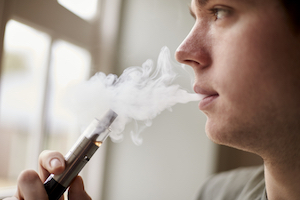
Vaping – the act of inhaling vapor from e-liquid through a personal vaporizer – has always been touted as “safer” than smoking conventional cigarettes. But according to new research, that might not be saying much.
In a world where drug use among teenagers is down overall, vaping and marijuana use are up. No surprise in a culture where a growing number of kids think getting wasted is “no big deal.”
So is vaping a safe substitute?
I wrote about vaping almost two years ago when more and more kids began disappearing into a mistat hangouts, on street corners, and even in school parking lots. The number of teens who vape continues to rise; roughly 28% of high school seniors now admit to vaping in the past year alone.
It’s easy to see why so many young people prefer vaping over the old fashioned cigarettes of yesteryear. There’s no bad breath (or smell of smoke since it’s actually smokeless), nor any risk of burns (because, again, there isn’t an actual fire). Vapers also claim their hobby – or habit? – is cheaper than conventional cigarettes…which isn’t hard to believe since the average cost of a pack of cigarettes is now $6.16. But the claim that vapers love to repeat the most – that vaping is less likely to result in cancer or other smoking-related diseases – is now in the crosshairs of several researchers.
The Bloomberg School of Public Health at Johns Hopkins University has found that electronic smoking devices can release “significant amounts of toxic metals” within the flavored vapors enjoyed by millions. Analyzing the equipment of 56 different users, researchers found traces of lead, chromium, manganese, and nickel. Problems stemming from the ingestion of these metals can be quite serious: lung, liver, and brain damage, upsets in the immune and cardiovascular systems…and some cancers.
The University of California (San Francisco) corroborated the cancer-related dangers of vaping when they released the results of their study that claimed “smoking e-cigarettes delivers cancer-causing chemicals” to users. Testing teens who smoked traditional cigarettes alongside teen vapers, researchers found that the latter could be contaminating themselves with the same harmful chemicals found in tobacco-based cigarettes. Unsurprisingly, they found that young vapers had “higher levels of the cancer-causing chemicals” in their system than non-smokers did. Their report was crystal clear: “The presence of harmful ingredients in e-cigarette vapor has been established; we can now say that these chemicals are found in the body of human adolescents who use these products.”
This damning research on vaping is just the latest in a long line of troublesome reports on the subject. Back in 2016, research by the American Academy of Pediatrics found that teenagers who vape are six times more likely to start smoking cigarettes than teens who never vaped.
Holy smoke!
Blowing Smoke
In spite of what proponents might claim, it seems vaping could be more problematic than originally thought. So, how should parents and youth workers respond when teenagers ask about the relative safety of vaping? What can we do to steer our kids away from the dangers associated with vaping (whether they’re “probable” or “actual”)? Here are two thoughts to consider as you try to guide the young people in your life.
- Avoid the problems associated with “lesser evils.” Since its inception, vaping has claimed to be less dangerous than traditional smoking. Let’s say their claim is true and that vaping isless dangerous than outright smoking. Is “less dangerous” really the line we want to tow with our kids’ futures? Parents who want their kids to avoid heroin don’t usually give them marijuana or alcohol because it’s less dangerous! Likewise, youth leaders who denounce pre-marital sex to their students don’t suggest porn as a replacement…because it’s a problem, too. Let’s skip the “lesser evil” argument when it comes to our kids and address the issue head on in a compassionate way. Give them real solutions to real problems…not just smaller problems.
- Lead by example. It doesn’t matter what you say, teach, or advise on vaping (or smoking) if your model contradicts your message. You have to practice what you preach, so to speak. If we expect our kids to steer clear of vaping, we have to lead them by our example. There isn’t any room for hypocrisy on this issue, or any issue for that matter. Just like you and me, young people respond most favorably to a strong example. Provide it!
Don’t allow your kids’ views on vaping to get clouded by the voices screaming from both sides of the issue. Remember, most of them will say anything to make a buck…or a billion bucks. To clear the smoke, give teens a consistent message and example.
David R. Smith
David R. Smith is the author of several books including Christianity... It's Like This and speaks to parents and leaders across the U.S. David is a 15-year youth ministry veteran, now a senior pastor, who specializes in sharing the gospel, and equipping others do the same. David provides free resources to anyone who works with teenagers on his website, DavidRSmith.org David resides with his wife and son in Tampa, Florida.




